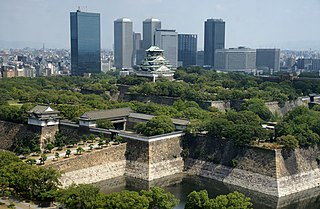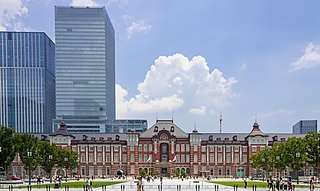 W
WThe Akihabara Radio Kaikan , Akihabara Radio Hall is a commercial building in Tokyo and is one of the most well-known landmarks in the Akihabara district. The recent building was built in 2014 after the old building was demolished in 2011. The building is 46.5 m high, is ten levels from the ground floor and has two basement levels. The current building primarily hosts stores selling otaku goods.
 W
WChiba Shrine is a Shinto shrine located in Chūō-ku, Chiba City, Chiba Prefecture. Originally a Buddhist temple dedicated to the deity Myōken, the patron of the Chiba clan, it was converted into a Shinto shrine dedicated to Ame-no-Minakanushi during the Meiji period.
 W
WKōshi-byō (孔子廟) is a Confucian temple in Nagasaki, Japan. Today the land on which it stands is owned by the Chinese Embassy in Tokyo.
 W
WFushimi Castle , also known as Momoyama Castle or Fushimi-Momoyama Castle, is a Japanese castle located in Fushimi Ward, Kyoto.
 W
WThe Golden Tea Room was a portable gilded chashitsu constructed during the late 16th century Azuchi–Momoyama period for the Japanese regent Lord Toyotomi Hideyoshi's tea ceremonies. The original Golden Tea Room is lost, but a number of reconstructions have been made.
 W
WHassō-an (八窓庵) is a historic chashitsu located today in Sapporo, Hokkaido, northern Japan. The name means “eight-window tea house”.
 W
WHiroshima Castle , sometimes called Carp Castle , is a castle in Hiroshima, Japan that was the home of the daimyō of the Hiroshima han (fief). The castle was originally constructed in the 1590s, but was destroyed by the atomic bombing on August 6, 1945. The castle was rebuilt in 1958, a replica of the original that now serves as a museum of Hiroshima's history before World War II.
 W
WHiroshima Gokoku Jinja (広島護国神社) is a Japanese Shinto Shrine in Hiroshima, Japan.
 W
WHoly Resurrection Cathedral , also known as Nikorai-do , in Chiyoda, Tokyo, is the main cathedral of the Japanese Orthodox Church.
 W
WThe Immaculate Conception Cathedral (無原罪の聖母司教座聖堂) also St. Mary's Cathedral, often known as Urakami Cathedral after its location Urakami, is a Roman Catholic cathedral located in Motoomachi, Nagasaki, Japan.
 W
WThe Ise Grand Shrine , located in Ise, Mie Prefecture of Japan, is a Shinto shrine dedicated to the sun goddess Amaterasu. Officially known simply as Jingū (神宮), Ise Jingū is a shrine complex composed of many Shinto shrines centered on two main shrines, Naikū (内宮) and Gekū (外宮).
 W
WKanda Shrine , is a Shinto shrine located in Chiyoda, Tokyo, Japan. The shrine dates back 1,270 years, but the current structure was rebuilt several times due to fire and earthquakes. It is situated in one of the most expensive estate areas of Tokyo. Kanda Shrine was an important shrine to both the warrior class and citizens of Japan, especially during the Edo period, when shōgun Tokugawa Ieyasu paid his respects at Kanda Shrine. Due in part to the proximity of the Kanda Shrine to Akihabara, the shrine has become a mecca for technophiles who frequent Akihabara.
 W
WKinkaku-ji , officially named Rokuon-ji , is a Zen Buddhist temple in Kyoto, Japan. It is one of the most popular buildings in Kyoto, attracting many visitors annually. It is designated as a National Special Historic Site, a National Special Landscape and is one of 17 locations making up the Historic Monuments of Ancient Kyoto which are World Heritage Sites.
 W
WMeiji-mura is an open-air architectural museum/theme park in Inuyama, near Nagoya in Aichi prefecture, Japan. It was opened on March 18, 1965. The museum preserves historic buildings from Japan's Meiji (1867–1912), Taisho (1912–1926), and early Shōwa (1926–1989) periods. Over 60 historical buildings have been moved and reconstructed onto 1 square kilometre of rolling hills alongside Lake Iruka. The most noteworthy building there is the reconstructed main entrance and lobby of Frank Lloyd Wright's landmark Imperial Hotel, which originally stood in Tokyo from 1923 to 1967, when the main structure was demolished to make way for a new, larger version of the hotel.
 W
WNagoya Castle is a Japanese castle located in Nagoya, Japan.
 W
WŌhi Shrine, also known as Funabashi Daijingū (船橋大神宮), is a Shinto shrine dedicated to the sun goddess Amaterasu located in the city of Funabashi in Chiba Prefecture, Japan.
 W
WOsaka Castle is a Japanese castle in Chūō-ku, Osaka, Japan. The castle is one of Japan's most famous landmarks and it played a major role in the unification of Japan during the sixteenth century of the Azuchi-Momoyama period.
 W
WSarumen Chaseki (猿面茶席) is a historic chashitsu located in Nagoya Castle, central Japan. Sarumen Chaseki and Bōgaku Chaseki are collectively called Sarumen Bōgaku Chaseki (猿面望嶽茶席).
 W
WThe Tokyo Imperial Palace is the main residence of the Emperor of Japan. It is a large park-like area located in the Chiyoda district of the Chiyoda ward of Tokyo and contains several buildings including the Fukiage Palace where the Emperor has his living quarters, the main palace where various ceremonies and receptions take place, some residences of the Imperial Family, an archive, museums and administrative offices.
 W
WTokyo Station is a railway station in Chiyoda, Tokyo, Japan. The original station is located in Chiyoda's Marunouchi business district near the Imperial Palace grounds. The newer Eastern extension is not far from the Ginza commercial district. Due to the large area covered by the station, it is divided into the Marunouchi (west) and Yaesu (east) sides in its directional signage.
 W
WTsu Castle was a Japanese castle located in the city of Tsu, Mie Prefecture, Japan. During the Edo period, Tsu Castle was home to the Sudo clan, daimyō of Tsu Domain, who dominated the provinces of Ise and Iga under the Tokugawa shogunate. The castle was also known as "Anotsu-jō" (安濃津城) after the ancient name for Tsu. The castle ruins are a Prefectural Historic Site.